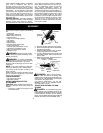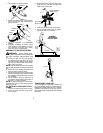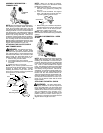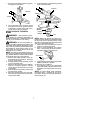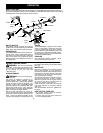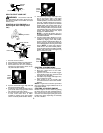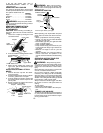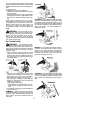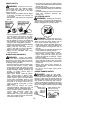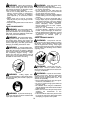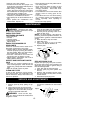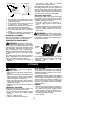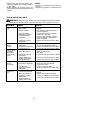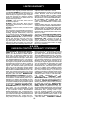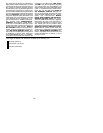
12
OPERATING INSTRUCTIONS FOR
USE WITH WEED BLADE
S
Blade Thr ust
is a r eaction that only occurs
when using a bladed unit. Thi s reaction can
cause serious injury such as amputation.
Carefully st udythis sect ion. Itis i mpor tantthat
you understand what causes blade thrust,
how you can reduce the chance of its
occurring, and howyou can remain in control
of unit if blade thrust occurs.
S
WHA T CAUSES BLADE THRUST
--
Blade
Thrust
can occur when the spinning blade
contacts an object that it does not cut. This
contact causesthe b ladeto stopfor a ninstant
and then suddenly move or “thrust” away
from the obj ect that w as h it. The “thrusting”
reaction can be v iolent enough to cause the
operator to be propelled i n any direction and
lose control of the unit. The uncontr olled unit
can cause ser ious injury if the blade contacts
the operator or others.
S
WHEN BLADE T HRUST OCCURS
--
Blade Thrust
can occur without warning if
the blade snags, stalls, or binds. This is
more likely to occur in areas where it is
difficult to see the material being cut. By
using the unit properly, the occurrence of
blade thrust will be reduced and the
operator will be less likely to lose control.
S
Cutonly grass, weeds, andwoody brushup
to 1/2 inch in diameter with the weed blade.
Do not let the blade contact material it
cannot cut such as stumps, rocks, fences,
metal, etc., orclusters ofhard, woody brush
having a diameter greater than 1/2 inch.
S
Keep the blade sharp. A dull blade is more
likely to snag and thrust.
S
Cut only at full throttle. The blade will have
maximum cutting power and is less likely to
bind or stall.
S
“Feed” the blade deliberately and not too
rapidly.The blade can thrust away if it isfed
too rapidly.
S
Cut onl yfrom y ourleft to yourright. Cuttingon
right side of the shield will throw debris away
from the operator.
S
Use the shoulder strap and keep a firm g r ip
on the unit with both hands. A properly
adjusted shoulder st rap will support the
weight of the unit, freeing your arms and
hands t ocontroland guide the cutting m otion.
S
Keep feet comfortably spr ead apart and
braced for a possible sudden, rapid thrust of
unit. Do not overr each. Keep firm footing and
balance.
S
Keep blade below waist level; it will be
easier to maintain control of unit.
S
Donot raise theengine above y ourwaistas
the blade can come dangerously close to
your body.
S
Do not swing unit with such force that you
are in danger of losing your balance.
Bring the engine to cutting speed before en-
tering the material to be cut.If the blade does
not turn whenyou squeeze the t hrottle trigger,
make sure tube is fully inserted into the en-
gine.
Always release the throttle trigger and allow
engine to return to idle speed when not cut-
ting. The blade should not turn while the en-
gine is running at idle. If the blade turns atidle,
do not use your unit. Refer to the CARBURE-
TOR ADJUSTMENT section or contact your
authorized service dealer.
S
Maintain good firm footing while using the
unit. Do this by planting feet firmly in a
comfortable apart position.
S
Cut while swinging the upper part of your
body from left t o right.
S
Asyoumove forward tothe next areatocut,
be sure to maintain your balance and
footing.
Cut using the 2
o’clock t o 4 o’clock
position of the
blade
2 o’clock
4 o’clock
RECOMMENDED CUTTING POSITION
WARNING:
The operator or others
must nottryto clear awaycut material with the
engine running or the blade turning to avoid
serious injury. Stop engine and blade before
removing materials wrapped around blade or
tube.
ADDITIONAL SAFETY RULES
FOR OPTIONAL A TTACHMENTS
WARNING:
For each optional at-
tachment used, read entire instruction manu-
al before use and follow all warnings and in-
structions in manual and on attachment.
WARNING:
Ensure handlebar re-
mains installed on upper tube (engine end of
unit) at all times.
Handlebar



